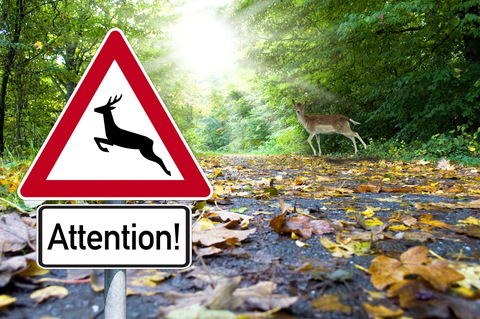Wildlife-related crashes increase during fall migration

Autumn wildlife migration throughout North America puts us at risk, especially during evening hours when critters typically are on the move.
"More than 90 percent of wildlife collisions occur at night," said Officer Adrian Quintero of the California Highway Patrol.
Some 200 people die every year and thousands are injured in the U.S. alone from wildlife-related vehicle accidents, according to reports from the National Highway Traffic Safety Administration. Average cost of vehicle repairs is about $2800.
In one recent study, Colorado officials have designated “wildlife zones” that reduce traffic speeds and increase speeding fines during peak migration months such as October and November. In British Columbia, the Wildlife Collision Prevention Program seeks to prevent wildlife-related collisions through education.
How can you avoid extensive damage to your vehicle and possible severe injury?
"In an effort to minimize these collisions we are asking people to use their high beams when driving at night and slow down, especially on curvy roads," Officer Quintero said. "Drivers need to minimize distractions such as cell phone use."
Part of the problem is simply in the numbers. More people are driving and they are driving more miles than ever. Americans alone drove about 3 trillion miles annually—nearly double what was driven in 1980.
Also, animals are being flushed out of natural environments as roadways and new home construction encroaches on their habitat. Highways cut across historical migration paths or bisect locations for food and shelter.
Crashes involving big game—deer, elk, moose—can cause severe vehicle damage and inflict injury on occupants.
"A deer can go through the windshield and cause a fatal accident," said Tully Lehman of the Insurance Information Network of California. "The cost can run up quickly because today's vehicles have so much electronic equipment. "In California, the CHP recently worked with the state Department of Transportation to reduce collisions along remote Sierra roads. A new batch of signs warns drivers to watch for animals crossing the roadway.
Other states are trying to prevent animal-related crashes by turning to technology. Some states have tested sound systems that emit a signal when cars enter wildlife crossing zones.
In Minnesota, the state Transportation Department installed flashing signals that warn of approaching deer. The Maine Department of Transportation is considering a Large Animal Warning System, which uses photoelectric beams to detect animals and activate a warning sign.
"You can put a deer whistle on your car but they don't always work," Lehman said.
Perhaps the best way of avoiding wildlife-related crashes is to alter driving behavior, Office Quintero said. He offered the following suggestions for travelers:
- Drive with your high beams at night.
- Make sure your headlights are clean and bright. You can improve headlight brightness by getting your headlights restored if they turned yellow. Also, headlight bulbs can lose as much as 20% of their brightness every year and may need to be replaced.
- Clean your vehicle windshield often to prevent glare and improve visibility. For instance, dust accumulation may not cause problems during the day but can severely restrict visibility at sunset.
- Reduce speeds on curvy roads. If you can't see around the corner, you may be surprised by a deer in your roadway and have no time to take evasive maneuvers.
- Use a hands-free device if you plan to talk on your cell phone while driving. Remember, hands-free laws have been implemented in many states.
- Do not drive after drinking especially on mountain roads. Alcohol remains one of leading causes of accidents, including wildlife-related crashes.
"Maximize your visibility and minimize distractions," Officer Quintero said. "Your car travels about 90 feet per seconds at 60 miles per hour. A three second distraction means your vehicle has just about covered the length of a football field."